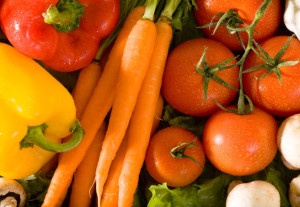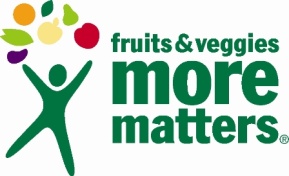Fruits & Veggies – More Matters®is a non-profit organization focusing on helping you eat more fruits and vegetables to better your health. September is designated as Fruits & Veggies – More Matters Month®. According to the Fruits & Veggies – More Matters website, 90 percent of adults and children do not eat the suggested amount…
It’s National Eat Your Vegetables Day!
/1 Comment/by Bonnie R. Giller
Vegetables are a vital part of your daily intake that provides several health benefits. Remember the old adage, “you are what you eat”? If you remember your vegetables, than you are one step closer to being the picture of health. Vegetables are nutrient dense, that is, they carry a greater nutrient contribution than calorie contribution. …
Celebrate National Vegetarian Awareness Week
/4 Comments/by Bonnie R. Giller
The second week of September is National Vegetarian Awareness Week! With more restaurants offering vegetarian menu options, supermarkets carrying more vegetarian products, and farmer’s markets popping up left and right, now is a great time to explore leading a more plant based lifestyle. There is a whole host of health benefits that you can gain…
Foods to Choose for Healthy Eyes
/0 Comments/by Bonnie R. GillerEating certain foods can help to reduce the risk of cataracts and eye disease. Below are foods that encourage preventative eye care. Fatty Fish: Fatty fish contains Omega 3 fatty acids such as DHA, which is recommended for dry eyes and which help to restore the structural support of the eye’s membranes. Examples of fatty…
Decorate your Plate with Fruits & Vegetables of the Rainbow
/0 Comments/by Bonnie R. GillerIf you didn’t reach your fruit and vegetable goal yesterday, here are a few ideas that may help to inspire you for the days ahead: Swap your BLT sandwich for baked beans or grilled mushrooms and tomato on whole grain toast Include vegetables, such as baby spinach, in pasta sauces and risottos. Stir through at…
Summer 2009: To Your Health
/0 Comments/by Bonnie R. GillerIn this Issue: Keep your Skin Healthy from the Inside Out! Celebrate National Men’s Health Week Proper Hydration During the Summer Months Enjoy Trail Mix Day this August, but Beware of Fat Traps! Freshen Up this Summer with some Tasty Fruits and Veggies Feature Food of the Month: Quinoa Recipe of the Month: Quinoa and…
Heart Healthy Nutrition Guidelines
/0 Comments/by Bonnie R. GillerTo help you get started on your new healthy outlook, follow these simple suggestions for eating healthy: Limit saturated fats. Aim for less than 7% of your total daily calories from saturated fat, and choose foods that will help keep your daily cholesterol intake under 300 milligrams. Get involved in some sort of physical activity…
Food Sources of Lutein & Zeaxanthin
/0 Comments/by Bonnie R. GillerLutein and zeaxanthin are primarily found in dark green and leafy vegetables, such as kale, collard greens, and turnip greens. They are also present in lesser amounts in corn, broccoli, green beans, peas, Brussels sprouts, cabbage, orange peppers, persimmons, kiwi, honeydew, and tangerines. Food Item Serving Size Lutein & Zeaxanthin (mg) Kale, cooked 1 cup…
Spring 2008: To Your Health
/0 Comments/by Bonnie R. GillerIn this Issue: Celebrating the 27th Anniversary of National Nutrition Month How Eating Breakfast Can Benefit Children The Link Between a Healthy Diet & Cancer The Best Foods for Spring Eat Your Way to a Good Night’s Sleep Feature Food of the Month: Figs Healthy Recipe: Fig and Oat Bars Celebrating the 27th Anniversary of…
DASH Eating Plan
/0 Comments/by Bonnie R. GillerThe meal pattern below is rich in low fat dairy foods, whole grains, fruits and vegetables and follows the DASH Meal Planning guidelines. For many people, following the DASH eating style can be an easy way to prevent or manage their high blood pressure. FOOD GROUP DAILY SERVINGS 1 SERVING EQUALS Milk and Dairy 2-3…
Decorate your Plate with Fruits & Vegetables of the Rainbow
/0 Comments/by Bonnie R. GillerIf you didn’t reach your fruit and vegetable goal yesterday, here are a few ideas that may help to inspire you for the days ahead: Swap your BLT sandwich for baked beans or grilled mushrooms and tomato on whole grain toast Include vegetables, such as baby spinach, in pasta sauces and risottos. Stir through at…
Fruit and Veggies Do’s and Don’ts
/0 Comments/by Bonnie R. GillerDo’s: Eat a variety of fruits and vegetables from the colors of the rainbow. Every color represents different vitamins and minerals that are essential for good health—so eat up! Try to include dark, rich yellow, red, and orange colored fruits and vegetables to your daily meal plans. These are rich in antioxidants and other nutrients…
The information on this website is for informational and educational purposes only. It is not intended as a substitute for professional medical advice or the care of a physician. Do not use this information to diagnose or treat a health problem or disease. If you suspect you have a health problem, please contact your health care provider.

